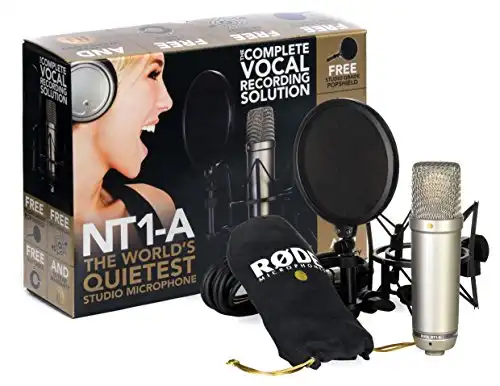Ask a group of podcasters or YouTubers what their preferred microphone is, and the
Released in 2003, the NT1A is one of
We decided to find out! Below, we’ve taken an in-depth look at the
Table of Contents
Rode NT1A
One of the world's quietest studio mics.
Design
Let’s start by taking a look at the overall design of the
The entire microphone is made from an all-metal construction, and this ensures that it is as durable as possible and keeps the condenser capsule well protected.
So, in the instance of it accidentally falling against your desk or getting bumped when you’re gesticulating, there’s minimal chance of it getting damaged.
As an extra layer of protection, the metal used in the construction of the
Another fantastic design aspect the
This reduced weight also makes it much easier to transport, so if you’d like to take your show on the road, you won’t feel weighed down by it. Also, let’s not forget that the durability of this microphone means it’s less likely to suffer from bumps and knocks during transport.
Sound
Now, let’s take a look at what the
This is its first tool in creating crystal clear vocals and ensuring that the person’s voice is recreated as lifelike as possible once converted into an electrical signal.
This condenser capsule works alongside the
A cardioid polar pickup pattern only picks up sound coming from a 180º arc directly in front of the microphone. By doing this, it focuses on your vocals while simultaneously blocking out any background noise. The result is super clear, ambient noise-free recordings.
It also has a side-address design, and this means that it needs to be placed vertically when in use. This may not seem like something that would have much of an impact on the quality of sound it produces; however, it does mean that you’re more comfortable when using it.
In turn, your vocals will relax, and the entire recording will sound more natural.
Frequency Range
Another thing that helps the
Many
Self-Noise
Have you ever listened to a podcast and noticed a buzzing sound or electrical interference in those small moments of silence? This comes from the microphone’s self-noise levels, and if these levels are too loud, the entire episode can sound unappealing.
Again, the
XLR Connection
The
In fact, many podcasters find that XLR cables are the best connections you could ever hope for. This is because they are much harder to accidentally unplug or tug out of the microphone while you’re recording than a USB cable.
The XLR connection port on the
Remember, however, that if you’re planning on recording directly to your computer, you’ll need to incorporate an audio interface as the middle man between your
The Focusrite Scarlett Solo and Focusrite 2i2 are amongst the best audio interfaces you can pair a
Price & Warranty
If there’s one downside to the
However, you indeed pay for quality when it comes to recording equipment, and there’s no doubt that the
This is made even more apparent by the generous 10-year warranty that is included with it. So, even though you may be paying more than you would for a different brand, you’ll be able to rest assured that you’ll be covered for repair or replacement in the unlikely event of something going wrong.
Accessories
The
This means that if you’ve already got a pop filter or a shock mount that you love and that you know well, you’ll be able to continue using it with the
How Does The NT1A Compare To The Rode NT1?
The
As far as durability and sound performance is concerned, there isn’t much difference between them. However, the
To begin with, it’s lighter in weight compared to the NT1. 70g lighter, to be exact. So, if you’re concerned about pairing a microphone with a boom arm or suspending it a shock mount, the
Both microphones contain the same gold-sputtered, 1” condenser capsule, the same cardioid pickup pattern, and the same frequency range.
However, the
Finally, another important difference between the two is that the
The NT1 also has a low self-noise level of 4.5dB, but removing that extra 0.5dB can make a huge difference, especially if you’re using your microphone for dramatic readings or for recording an audiobook.
You can read a more detailed breakdown of the differences between the
Conclusion
The
The sound quality it produces with its large condenser capsule and wide frequency range is second to none, and capturing clear vocals is incredibly important when you’re recording a podcast.
The cardioid pickup pattern further enhances the vocal recording capabilities of the
It’s not a cheap microphone, though. However, it is one that is built to last. The solid, all-metal construction ensures it is super durable, and a 10-year warranty backs its quality.
So, if you want a microphone that will last you for years, has a strong reputation behind it and will provide you with the sound quality you’re craving, the

